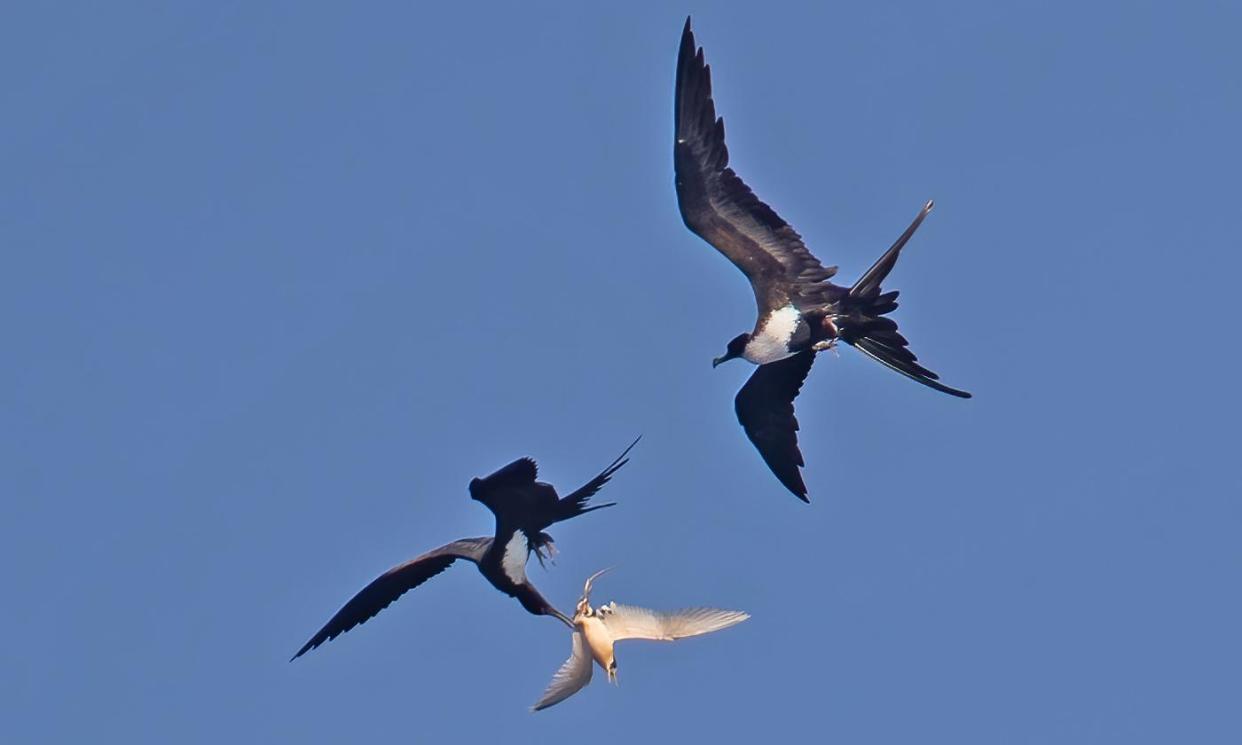Deadly avian flu strain could enter Australia via thieving migratory birds, scientists warn

Scientists have identified a new way for an aggressive strain of bird flu to enter Australia, via the habit of some migratory birds of harassing other birds and stealing their food and potentially their viruses.
Australia is the only continent to have so far escaped a virulent H5N1 strain of avian flu – known as 2.3.4.4b and discovered in Europe in 2021– that has devastated bird populations in other parts of the world.
Conservationists fear an arrival in Australia – considered to be “not if but when” – would have disastrous consequences for the country’s unique water birds and other species, such as sea lions, that have also seen mass casualties from the virus.
Scientists from three Australian universities, together with conservation group BirdLife International, have identified the behaviour of frigatebirds and skuas as an additional way the virus could spread from one species to another.
Those birds practice what is known as kleptoparasitism, where they harass other birds either on the ground or on-the-wing to the point where their victims either drop their prey or regurgitate their food.
The klepto birds could catch any viruses that are present in or around the food and then spread it among their own colonies and to other nearby bird populations.
In an article published in the journal Conservation Letters the scientists said the secondhand food was covered in saliva, which is known to carry a high viral load.
“We’re highlighting a plausible pathway not just for the virus to arrive in Australia but also broad transmission across the oceans,” said Simon Gorta, lead author of the research from the Centre for Ecosystem Science at the University of New South Wales.
Seabirds are already one of the world’s most threatened groups of birds. The virulent strain of the virus is thought to have spread mainly by close proximity, through contact with bird faeces and by contaminating shared water.
Related: New Zealand rushes vaccination of endangered birds before deadly strain of H5N1 bird flu arrives
Prof Richard Kingsford, a co-author of the research and also at UNSW, said: “Transmission among seabirds is a real concern because of their close contact and potential contamination of communal resources on densely packed breeding islands, as well as particular behaviours like predation and scavenging of infected individuals.”
Kingsford is about to lead an annual waterbird survey across the continent and he said he would be looking with trepidation for mass bird deaths.
Alex Berryman, an expert on threatened birds at BirdLife International and a co-author of the research, said: “There is no logical reason why this bird flu couldn’t reach Australia.
“We’re hugely worried as it has been fairly devastating for some species, and in Australia there are globally significant bird colonies.”
Dr Michelle Wille, a senior research fellow at the Centre for Pathogen Genomics at the University of Melbourne who was not involved in the research, said kleptoparasitism could be one of the many ways the virus was being spread.
“Unfortunately, without any real experimental data, this is just a hypothesis,” she said. “Whether these birds have a role to play in bringing the virus to Australia is unknown.
Related: Forgotten epidemic: with over 280 million birds dead how is the avian flu outbreak evolving?
“Based on our risk assessments, the most likely route of virus introduction into Australia is via long-distance migratory birds such as shorebirds using the East Asian-Australasian flyway, or seabirds breeding in Australia but spending the overwintering period in the northern hemisphere.”
Dr Frank Wong, a senior research scientist at CSIRO’s Australian Centre for Disease Preparedness and also not involved in the research, said any new information on how the virus might be spreading was valuable.
He said the most likely route for the strain to enter Australia was from the north, as it had already been detected in Indonesia and the Phillipines. But he said Antarctica was another potential route.
Detecting an arrival in Australia would be challenging, he said, as many areas were remote and mass mortality events could happen without being observed.


